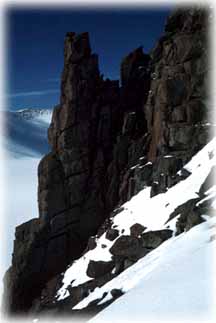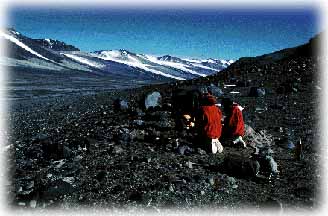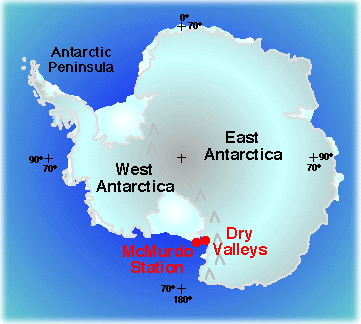
|
|





See Bill's Expedition Pictures!

I first dreamed of going to Antarctica at the age of 12. The dream never
died. Thirty-six years later and I'm on my way!
When I look back upon my life I feel fortunate that I married a wonderful
woman, adopted and raised six very ugly (but sweet) dogs, and chose teaching
as a career. As a high school and middle school teacher in Dover, Delaware
I've been able to do research in such places as India, North Africa, Mexico,
and Europe. These experiences led to further adventures in backpacking through
some of the most scenic wilderness in Western North America. As my interest
in wilderness increased I began organizing and leading teacher field studies
to the Grand Canyon, Alaska, Montana, and Hawaii.
In between research trips, field studies, and backpacking expeditions I
worked on a Masters at the University of Delaware and a Doctorate at the
University of Maryland; took a leave to work in Washington, DC, as a legislative
assistant (sponsored by the Triangle Coalition and the American Association
for the Advancement of Science); and worked as an National Science Foundation
research fellow at the American Geological Institute.
Follow Bill's Adventures in the American Southwest!
 I believe (hope?) that all that has gone before will help me in my research
in the Dry Valleys of Antarctica. I will study igneous rock formations with
a research group of five led by Dr. Bruce Marsh of Johns Hopkins University.
Over 95% of Antarctica is covered by ice. Researchers who want to study
rock formations to understand how the continent formed and has changed through
time, have a very difficult job finding places NOT covered by ice and snow!
The Dry Valleys offer one of few locations with exposed rock outcrop. I believe (hope?) that all that has gone before will help me in my research
in the Dry Valleys of Antarctica. I will study igneous rock formations with
a research group of five led by Dr. Bruce Marsh of Johns Hopkins University.
Over 95% of Antarctica is covered by ice. Researchers who want to study
rock formations to understand how the continent formed and has changed through
time, have a very difficult job finding places NOT covered by ice and snow!
The Dry Valleys offer one of few locations with exposed rock outcrop.
I will be working in a remote field site, so I may not be able to send my
electronic journal notes about our research and living experiences often.
I may resort to sending my computer disks back to McMurdo
by helicopter! Hopefully someone will then send them along to be posted
on these webpages. Keep an eye on my journal pages for the latest breaking
news!

On Bill's last day, he was scheduled on flight of
relatively few people (mechanical difficulties precluded Bill from leaving
earlier and bumped him to another flight - but that's all part of the Antarctic adventure). As Bill and the
others were waiting for the flight they got to know each other. One of the
passengers was Sir Edmund Hillary.


Three Dimensional Magma Dynamics in Large Sills
Principal Investigator: Bruce D Marsh,
Johns Hopkins University
I worked in the Dry Valleys region of Antarctica as part of a research team investigating igneous rocks - the type of rocks formed as molten magma cools and solidifies. The research team is parcticularly interested in why the igneous rocks occur where they do, and how long it took for the magma to cool. The rocks we studied are in structures called sills, which are horizontal, sheet-like intrusions of igneous rocks formed below the surface of the Earth. Sills do not cut across the layers of rocks they intrude - rather, they have borders that are parallel to them. Erosion subsequent to the sills' formation has left some of them exposed at the Earth's surface where we can study them. We want to understand their formation because much of the crust (outer shell of the Earth) may have been formed by the solidification of sheet-like bodies of magma.

The Dry Valleys offer views into Antarctica's past. Photograph courtesy
of the National Science Foundation.
We are working in Antarctica because there are excellent exposures of an important sill in the Dry Valleys, called the Basement Sill. It is thick (300 meters or 1000 feet) and quite extensive (greater than 5,000 cubic kilometers or 1200 cubic miles). Best of all, it contains a feature that allows us to examine how the sill filled with magma - a layer of large crystals (0.01 to 0.06 centimeters or 0.003 to 0.001 inches long) that varies in thickness, crystal size, and position within the sill.
The crystals, which are made of the mineral orthopyroxene, form an excellent marker layer because they are large and distinct. They crystallized out of the magma before the sill was created. As the magma moved into the sill, it carried a trail of these crystals with it. Variations in their distribution helps us determine how fast the magma filled, whether filling was episodic or continuous, and whether magma moved into the surrounding rocks at distinct points or along fissures. Some other large sills around the world contain layers of crystals, but the Basement Sill of Antarctica is one of the rare ones where natural exposures allow a marker layer to be traced in three dimensions.
By studying the Basement Sill, the researchers hope to learn details of processes controlling the structure of both oceanic and continental crust. Its formation will be compared to that of similar sheet-like magma bodies on Easter Island and Reunion Island. Discovering which features these large sills have in common will tell us which processes are most important in volcanic systems.

Bill Philips will be working close to McMurdo Station.

The Dry Valleys (yellow) offer a unique opportunity to observe rock formations
in Antarctica because they are not covered by thick ice!

Return to top of page
|






